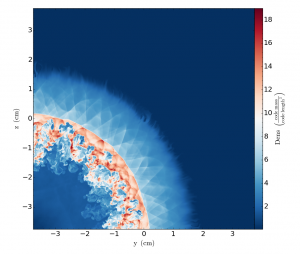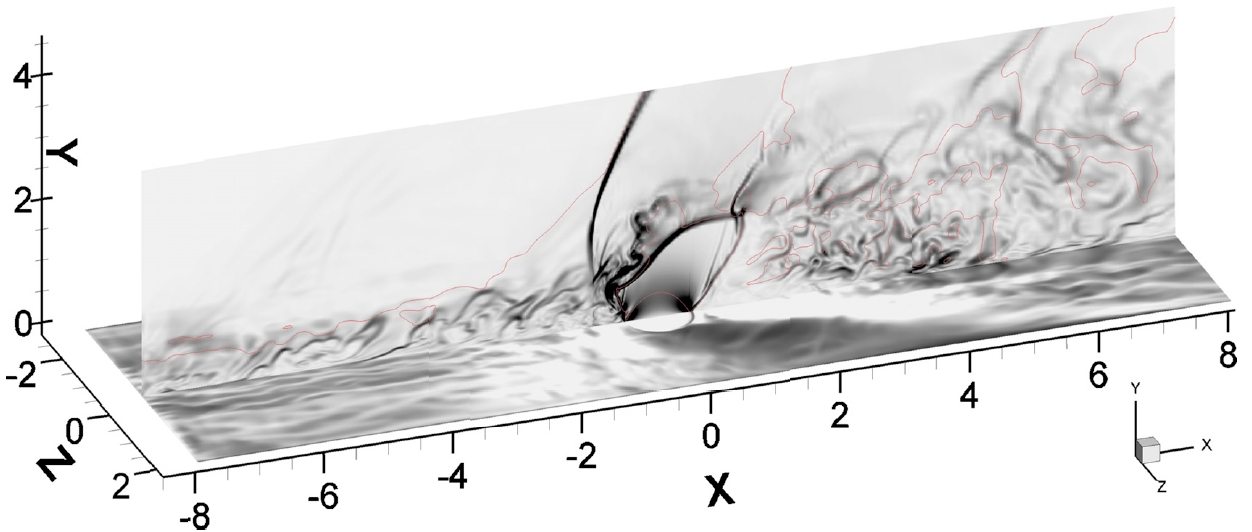Our group has conducted over a decade of work in the analysis of compressible turbulent mixing. We are pushing forward the state of the art in physical understanding of mixing under extreme conditions, using tools ranging from Direct Numerical Simulation, Large-Eddy-Simulation and developing reduced order models. The research benefits from very active collaborations with leading institutions worldwide.
In 2016, the University of Sydney hosted the principle conference in this field – the International Workshop on the Physics of Compressible Turbulent Mixing.
For more information, please contact: Assoc. Prof. Ben Thornber
Fundamental Mixing Layers
Our group employs a range of techniques to explore the fundamentals of compressible turbulent mixing layers, such as those generated from shock interactions (Richtmyer-Meshkov), shear layers (Kelvin-Helmholtz) and acceleration (Rayleigh-Taylor). Our key contributions include a deeper understanding of the influence of initial conditions on the self-similar state of mixing layers, the transition to turbulence, the mechanisms of energy and enstrophy transfer in compressible mixing layers, and the influence of Reynolds number on mixing layer development. We are employing our high resolution data to generate reduced order models for rapid computations.
The animation on the left shows the development of a shock-induced mixing layer, examined using Direct Numerical Simulation. In addition to winning the 2018 Australasian Fluid Mechanics Society video competition, it is also one of several computations undertaken at varying Reynolds numbers to elucidate the dependence of the mixing layer on Reynolds number. The image below shows a slice through a fully developed compressible shear layer.
For more information, see:
M Groom, B Thornber “Reynolds number dependence of turbulence induced by the Richtmyer–Meshkov instability using direct numerical simulations“, Journal of Fluid Mechanics 908, 2021
B. Thornber, J Griffond, O Poujade, N Attal, H Varshochi, P Bigdelou, P Ramaprabhu, B Olson, J Greenough, Y Zhou, O Schilling, KA Garside, RJR Williams, CA Batha, PA Kuchugov, ME Ladonkina, VF Tishkin, NV Zmitrenko, VB Rozanov, DL Youngs “Late-time growth rate, mixing, and anisotropy in the multimode narrowband Richtmyer–Meshkov instability: The θ-group collaboration“, Physics of Fluids 29 (10), 105107, 2017
B Thornber, J Griffond, P Bigdelou, I Boureima, P Ramaprabhu, O Schilling, RJR Williams “Turbulent transport and mixing in the multimode narrowband Richtmyer-Meshkov instability” Physics of Fluids 31 (9), 096105, 2019
M Groom, B Thornber “Direct numerical simulation of the multimode narrowband Richtmyer–Meshkov instability” Computers & Fluids 194, 104309, 2019
DL Youngs, B Thornber “Buoyancy–Drag modelling of bubble and spike distances for single-shock Richtmyer–Meshkov mixing” Physica D: Nonlinear Phenomena 410, 132517, 2020
DL Youngs, B Thornber “Early Time Modifications to the Buoyancy-Drag Model for Richtmyer–Meshkov Mixing” Journal of Fluids Engineering 142 (12), 2020

Inertial Confinement Fusion
Society faces a critical need for a long term energy source. In the long term, Inertial Confinement Fusion (ICF) provides a potential pathway towards utilisation of fusion power as an energy source. In ICF, powerful lasers are employed to rapidly compress a small sphere of deuterium/tritium to the required temperature and pressure to produce fusion. In the long term, such small spheres could be imploded multiple times per second, with each pulse providing a small release of energy. With even a modest conversion rate, a system could provide enough energy to sustain mankind for many centuries. However, fluid instabilities develop and these can prevent fusion being achieved.
Research within the FluD group aims to understand how the instabilities develop and transition to turbulence, and thus inform the future design of the fuel capsules, utilising very high resolution computations undertaken on several thousand computational cores. The animation on the left is illustrates the development of a turbulent mixing layer from linear growth, through to nonlinear, and finally resulting in a turbulent mixing layer. This is employing a new semi-Lagrangian, very high order accurate algorithm for the Euler equations in spherical coordinates. It highlights the development of perturbations.
For more information, please see:
M El Rafei, B Thornber “Numerical study and buoyancy–drag modeling of bubble and spike distances in three-dimensional spherical implosions” Physics of Fluids 32 (12), 124107, 2020
M El Rafei, M Flaig, DL Youngs, B Thornber “Three-dimensional simulations of turbulent mixing in spherical implosions“, Physics of fluids 31 (11), 114101, 2019
M El Rafei, B Thornber “Numerical Study of Compressible Turbulent Mixing in Spherical Implosions Comparing Different Initial Perturbations“, Proceedings of the 21st Australasian Fluid Mechanics Conference, 2020
M El Rafei, L Heidt, B Thornber “A comparison of a modified curvilinear approach for compressible problems in spherical geometry and a truly spherical high-order method“, Proceedings of the 21st Australasian Fluid Mechanics Conference, 2018

Supersonic Jets
Supersonic jets injected through a boundary layer have applications in flow control, aeroacoustic noise manipulation, control actuation and fuel injection in scramjets. This occurs as relatively small high speed jets can significantly modify the structure of a boundary layer, or disrupt the formation of coherent structures. Our research explores the pressure distributions, boundary layer disturbances, shock structures and mixing in sonic jets injected into high speed flows.An Unsteady LES of a jet into supersonic crossflow shown here.
For more information, please see:
ZA Rana, B Thornber, D Drikakis “Dynamics of sonic hydrogen jet injection and mixing inside scramjet combustor”, Engineering Applications of Computational Fluid Mechanics 7 (1), 13-39,2013
ZA Rana, B Thornber, D Drikakis, “Transverse jet injection into a supersonic turbulent cross-flow”, Physics of fluids 23 (4), 046103,2011
